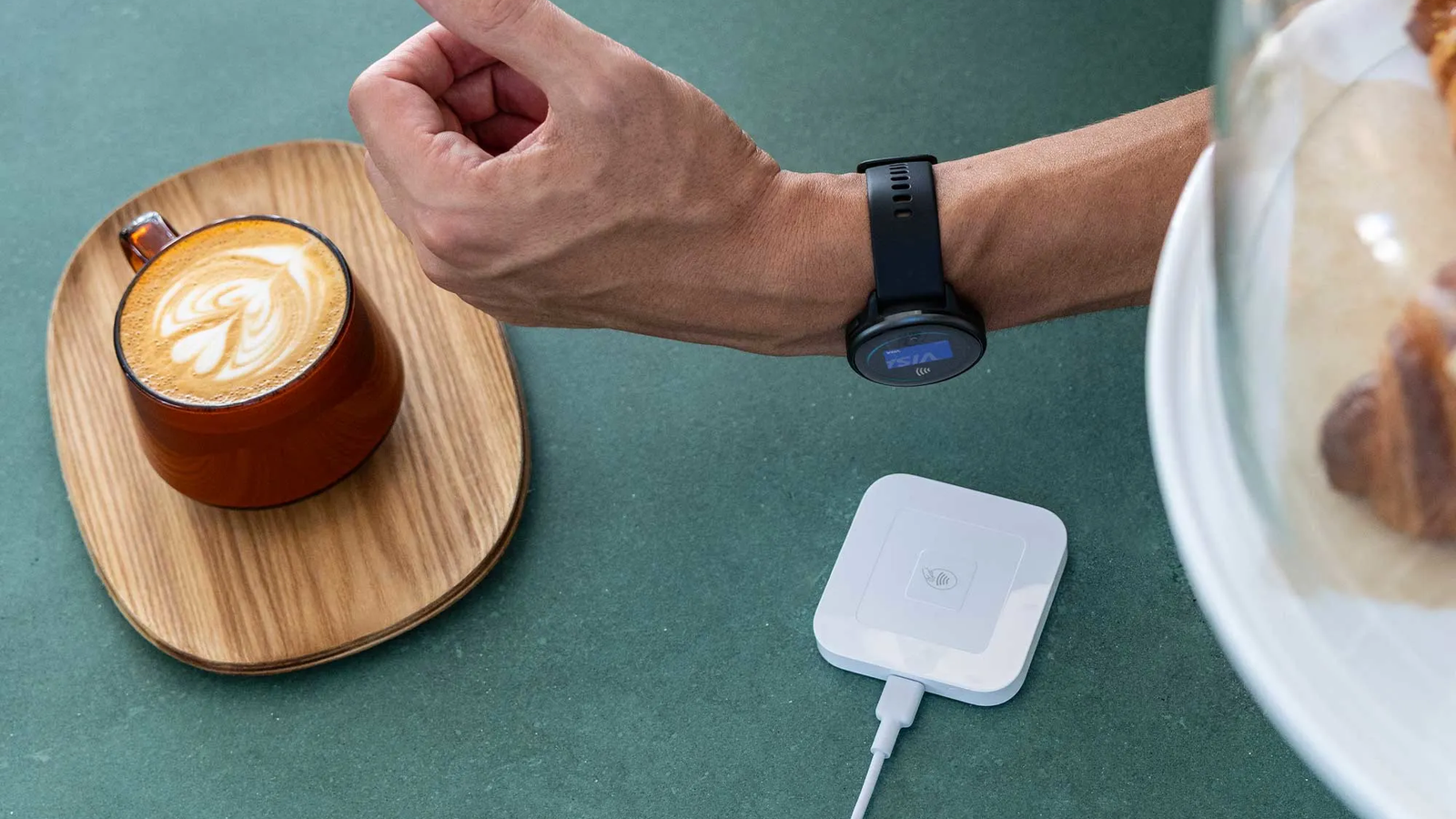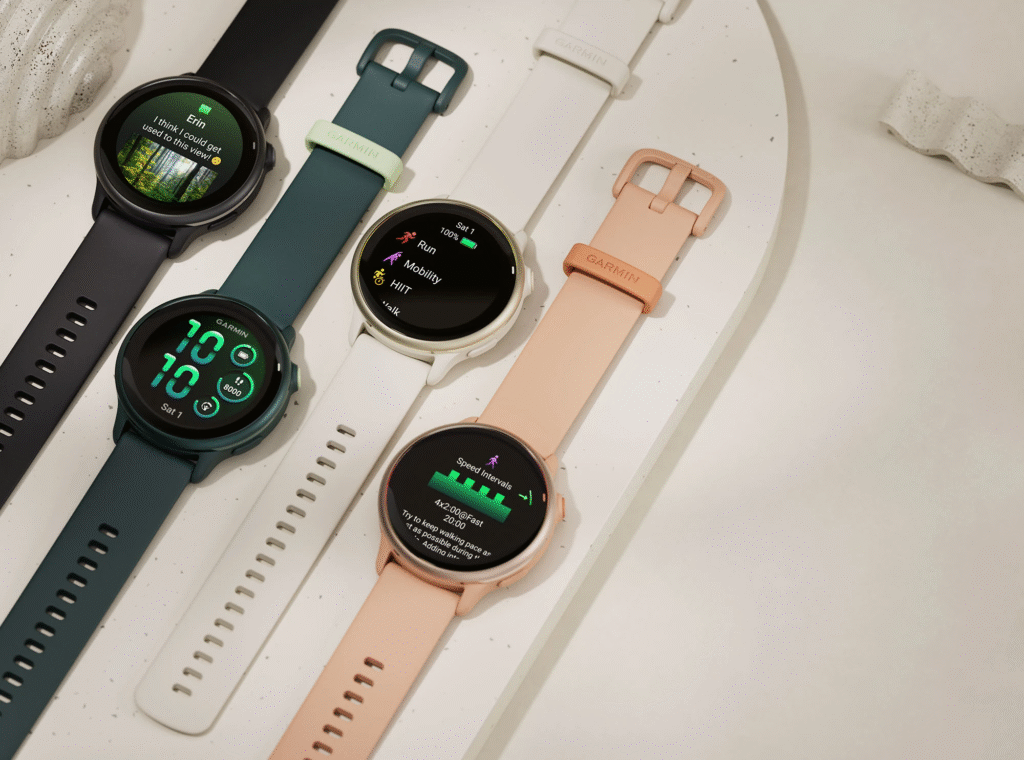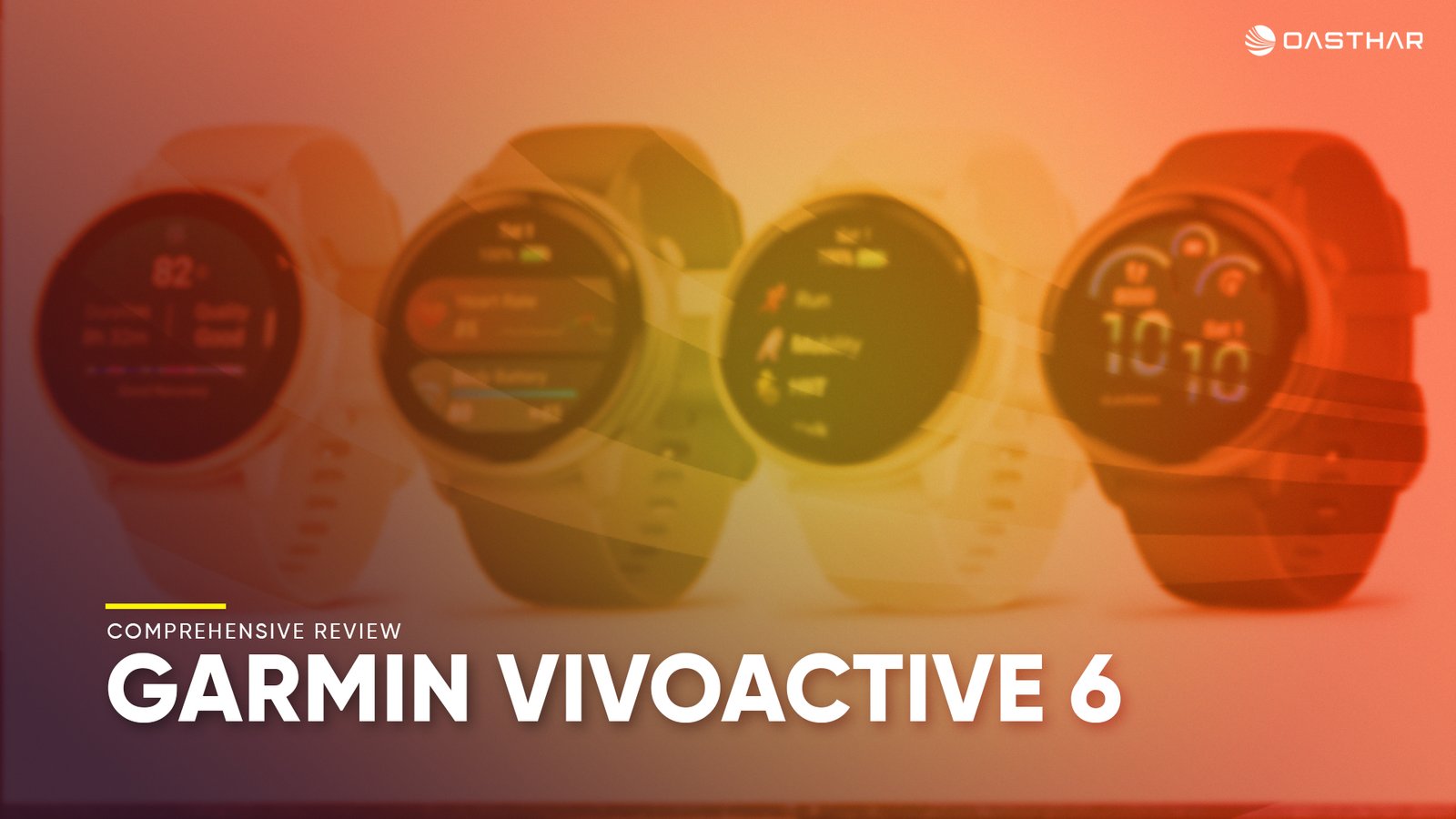Discover our in‑depth Garmin Vivoactive 6 review: design, display, performance, battery life, features, and value. Find out if this fitness smartwatch is worth it.
Curious about whether the Garmin Vivoactive 6 lives up to the hype? In this comprehensive review, we’ll dive into its sleek design, vibrant AMOLED display, advanced fitness tracking features, and impressive battery life.
You’ll learn how the Garmin Vivoactive 6 compares to its predecessor and rivals, explore its real‑world performance, and see if it truly deserves a spot on your wrist. By the end, you’ll have all the insights you need to decide if this $299 fitness smartwatch is the right companion for your active lifestyle.
Related: Xiaomi Watch S4 Review
Design & Build Quality

The Garmin Vivoactive 6 maintains the familiar, lightweight footprint of its predecessor, measuring 42 mm in diameter, 10.9 mm thick, and weighing just 23 g⁶. Its polymer-reinforced case and stainless‑steel bezel strike a balance between durability and style, feeling sturdy without sacrificing comfort during all‑day wear⁷. The silicone strap is soft against the skin, secures firmly with a traditional buckle, and is easily swappable for third‑party bands if you want a different look or material.
Underneath, Garmin retains the Elevate Gen4 optical heart‑rate sensor, which continues to deliver accurate HR readings during workouts and sleep cycles. The watch’s rear sensor cluster sits flush, minimizing pressure points even when your wrist flexes. While there’s no barometric altimeter—an omission that surprised some—Garmin still manages to offer running power and 3D distance metrics via GPS and accelerometer fusion⁴.
Subtle design tweaks include a slightly thinner case than the Vivoactive 5 (10.9 mm vs. 11.1 mm) and a refined button layout that makes menu navigation feel more intuitive⁸. The touchscreen remains responsive under sweat or rain, and two physical buttons provide reliable control during activities when swipes may misfire.
Overall, the Garmin Vivoactive 6’s build quality feels premium for the price. It balances ruggedness and refinement, making it suitable for both the gym and the office. Whether you’re pushing through high‑intensity intervals or typing at your desk, the Vivoactive 6 stays comfortably in place.
Display/Screen Quality

The Garmin Vivoactive 6 sports a 1.2‑inch AMOLED display with a 390×390‑pixel resolution—identical on paper to the Vivoactive 5 but noticeably brighter in practice². Outdoor visibility sees a marked improvement, with Garmin claiming a boost to over 1,000 nits (though exact figures remain undisclosed)². Under direct sunlight, text and data fields remain sharp and legible, reducing the need to shade your wrist during runs or rides.
Color reproduction is vibrant without feeling oversaturated, lending punch to activity animations and widget visuals. The always‑on mode conserves power by dimming the display between updates, yet retains enough clarity to glance at stats mid‑workout. Touch responsiveness is excellent, with smooth scrolling through widgets and menus even when wet or sweaty. Physical buttons serve as reliable backups for critical functions like start/stop and lap marking.
In low‑light settings, the display’s adaptive brightness adjusts seamlessly, preventing eye strain during nighttime use. Garmin’s watch faces take full advantage of the AMOLED panel, offering deep blacks and high contrast for a more refined look compared to traditional MIP screens⁴. Customizable data pages allow up to 8 data fields per screen, doubling the previous limit⁴ and making the most of the display real estate.
While the screen size may feel small compared to larger smartwatches, the pixel density ensures text and icons remain crisp. For a fitness‑focused wearable, the Garmin Vivoactive 6 strikes an excellent balance between battery efficiency and display quality, elevating everyday readability and workout tracking alike.
Performance & Software Experience

Under the hood, the Garmin Vivoactive 6 runs on Garmin’s proprietary OS, optimized for fitness tracking and battery efficiency. Navigation through menus and widgets is fluid, with near‑instantaneous responses to button presses and screen taps. Garmin’s expanded Connect IQ ecosystem allows third‑party apps and watch faces, though support remains more limited than Apple’s watchOS or Google’s Wear OS⁴.
Fitness features see the biggest software uplift. The Vivoactive 6 adds 50 sport profiles, including advanced modes like trail running, obstacle racing, and snowboarding—up from the Vivoactive 5’s roster⁴. Runners gain PacePro pacing strategies, running dynamics (ground contact time, vertical oscillation, stride length), and running power metrics without needing an external sensor⁴. Though it lacks an ECG sensor, its core health tracking—heart rate, SpO₂, stress, sleep—remains reliable and insightful⁷.
Smart features include Garmin Pay for contactless payments, onboard music storage for Spotify, Amazon Music, and YouTube Music³, and safety tools like incident detection with LiveTrack³. Notifications from Android or iOS devices display clearly, though reply options are limited compared to full-fledged smartwatches. There’s no built‑in microphone or speaker, so calls must be handled on your phone.
Software updates have refined the user interface, with a revamped settings menu and quicker access to key metrics. Daily suggested workouts provide basic guidance—though some testers found walking recommendations repetitive⁷. Overall, the Garmin Vivoactive 6’s software strikes a friendly balance between depth for athletes and simplicity for casual users.
Battery Life & Charging

Battery life remains a standout strength for the Garmin Vivoactive 6. Garmin rates it at up to 11 days in smartwatch mode and 21 hours in GPS mode³. In real‑world use, most users report 9–10 days of mixed activity tracking, notifications, and occasional music playback—still far exceeding Wear OS and Apple Watch alternatives⁹.
Charging is handled via a magnetic clip‑on cable that snaps securely to the watch’s rear contacts. A full charge from zero to 100 percent takes around 1.5 hours, making overnight top‑ups easy. Garmin’s power‑saving settings let you disable always‑on display, reduce sensor polling, or turn off smart notifications to eke out extra days when needed⁹.
Battery drain concerns are rare but occasionally reported; one user noted an unexpected overnight drop to 1 percent, though this appears to be an isolated firmware glitch rather than a systemic issue¹⁰. Garmin’s support documentation outlines best practices—like disabling Wi‑Fi when idle and limiting back‑to‑back GPS activities—to maximize longevity⁹.
Overall, the Garmin Vivoactive 6 delivers class‑leading endurance for a smartwatch with an AMOLED panel. Whether you’re training for a marathon or simply hate daily charging, its multi‑day runtime provides peace of mind that few competitors can match.
Connectivity & Features

The Garmin Vivoactive 6 supports GPS, GLONASS, Galileo, BeiDou, and QZSS, offering robust location tracking even in challenging environments². Bluetooth and Wi‑Fi enable seamless syncing with the Garmin Connect app, where you can analyze workouts, adjust settings, and download watch faces or apps from Connect IQ. There’s no LTE option, so features like LiveTrack require a tethered smartphone.
Health sensors include Garmin’s Elevate Gen4 wrist HR monitor, SpO₂ pulse oximeter, and a 3‑axis compass. While there’s no barometric altimeter or ECG sensor, advanced algorithms infer elevation changes and deliver running power without extra hardware⁴. The watch also offers built‑in incident detection and assistance alerts, which automatically send your location to emergency contacts if a fall is detected.
Music features let you store up to 2 GB of songs (approx. 500 tracks) on the watch and control playback for Spotify, Amazon Music, and YouTube Music—even offline³. Garmin Pay supports major banks for contactless payments, freeing you from your wallet on quick errands or gym sessions. Notifications for calls, texts, and apps appear promptly, though on‑watch interaction remains limited to dismiss or view only.
For sports, the Vivoactive 6 provides animated on‑screen workouts, PacePro strategies, and customizable data screens—up to 8 fields per page. Safety and tracking tools like LiveTrack and incident detection round out its connectivity suite, making the Garmin Vivoactive 6 a well‑connected fitness companion.
User Experience & Practicality

Wearing the Garmin Vivoactive 6 feels comfortable for 24/7 use. The lightweight design and soft silicone strap rarely irritate, even during sleep tracking. The revamped UI makes navigating widgets and metrics intuitive; a swipe or button press takes you where you need to go without digging through nested menus.
Activity tracking is largely automatic: steps, floors climbed, stress, and Body Battery energy scores update throughout the day. Sleep analysis breaks down light, deep, and REM stages, with a new Smart Wake alarm that gently vibrates you awake at the optimal moment—though some users found wake suggestions inconsistent⁷. Female health tracking covers menstrual cycles and pregnancy, seamlessly integrated into the Garmin Connect app.
During workouts, the combination of touchscreen and physical buttons ensures reliable control. The vibration motor is strong enough to alert you mid‑run, and the absence of a speaker doesn’t hinder training. Customizable alerts—like lap, pace, and HR zones—keep you informed without glancing at the screen constantly.
Daily life perks include weather updates, calendar sync, and find‑my‑phone functionality. The Vivoactive 6’s water resistance (5 ATM) makes it suitable for pool swims and showering. Overall, its blend of automation and manual control creates a practical, low‑maintenance user experience that adapts to both fitness enthusiasts and casual wearers.
Pricing & Value for Money

At an MSRP of $299, the Garmin Vivoactive 6 sits squarely between budget fitness bands and high‑end smartwatches³. Compared to the Vivoactive 5 at launch, it retains the same price while offering double the storage and enhanced features⁴.
Rivals like the Apple Watch SE and Google Pixel Watch often undercut battery life (1–2 days) and lack specialized fitness tools, making the Vivoactive 6 a compelling alternative for athletes and outdoorsy users. Even Garmin’s own Venu series commands a premium for ECG and AMOLED color, yet lacks route‑following features found here⁴.
On Amazon, street prices sometimes dip to $249¹¹, further sweetening the deal. For under $300, you get advanced sports metrics, multi‑day battery life, music storage, and contactless payments—features that would cost significantly more on other platforms.
Considering its balanced feature set, robust build, and Garmin’s strong post‑purchase support, the Vivoactive 6 delivers exceptional bang for your buck. It addresses core needs—fitness tracking, battery endurance, and comfort—without unnecessary bloat, making it one of 2025’s best fitness smartwatch values.
Final Verdict
The Garmin Vivoactive 6 refines an already winning formula, blending sleek design, bright AMOLED clarity, and advanced fitness tools in a single, affordable package. Its 11‑day battery, 50 sport profiles, and doubled 8 GB storage stand out in a crowded field³⁴. While it forgoes an ECG sensor and calls support, it doubles down on what matters most for active users: accurate tracking, robust metrics, and real‑world practicality. For $299 (often less on sale), the Garmin Vivoactive 6 is a top pick for anyone seeking a versatile, no‑nonsense fitness smartwatch that outlasts and outperforms many pricier competitors.




